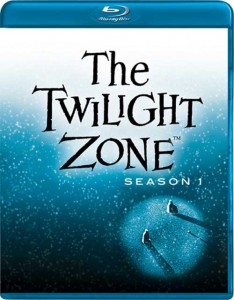 One week ago saw the first of a series of posts by Arlen Schumer exploring The Twilight Zone. (Part 1 can be read here.) Here in Part 2 Schumer continues his analysis, looking at the influence of the series on television past and present, and beginning an exploration of themes of the series:
One week ago saw the first of a series of posts by Arlen Schumer exploring The Twilight Zone. (Part 1 can be read here.) Here in Part 2 Schumer continues his analysis, looking at the influence of the series on television past and present, and beginning an exploration of themes of the series:
Star Trek would have simply been a glimmer in Gene Roddenberry’s eye without Serling and The Twilight Zone tackling many of the same socio-political themes Trek would become known for; its first episode was entrusted to veteran Twilight Zone sci-fi scribe George Clayton Johnson, and Roddenberry himself delivered the eulogy at Serling’s funeral (after his premature death at the age of 50 in 1975):
“No one could know Serling, or view or read his work, without recognizing his deep affection for humanity, his sympathetically enthusiastic curiosity about us, and his determination to enlarge our horizons by giving us a better understanding of ourselves. He dreamed of much for us, and demanded much of himself, perhaps more than was possible for either in this time and place. But it is that quality of dreams and demands that makes the ones like Rod Serling rare…and always irreplaceable.”
The series’ impact is felt more obliquely in the edgier, darker works of directors like David Lynch, whose 1977 debut film, the “undergroundy,” black and white Eraserhead, his revealing of the seedy underbelly of suburbia in ‘86’s Blue Velvet, and his meditation on dreams and reality in his 2001 masterpiece Mulholland Drive, all reveal his own private Twilight Zone.
M. Night Shyamalan’s entire career (and Tim Burton’s, to a lesser degree) can be seen as an ongoing homage to The Twilight Zone; the smash hit that made him, 1999’s The Sixth Sense (also the name of a short-lived 1972 supernatural TV knockoff of The Twilight Zone), is a derivation (and conflation) of two classic first-season Zone episodes, “A Passage for Trumpet” and “The Hitch-Hiker.”
Chris Carter’s The X-Files? ‘Nuff said. JJ Abrams’ Lost? Serling had a brief (17 episode) post-Twilight Zone series in the Fall of ’69 called The New People, about a group of young people…survivors of an airplane crash…on a deserted island! Abrams’ new hit Fringe is as much Twilight Zone redux as X-Files, as he said so himself in Rollingstone, which presented its 2009 “Most Shocking Season Finale” award to Fringe, enthusing “Not since The Twilight Zone has a twist ending inspired so many goosebumps,” to which Abrams responded, “It felt exactly like the kind of thing Rod Serling would have done.”
The Twilight Zone is a legacy that continues to teach, entertain, and inspire; it is a measure of that legacy that Rod Serling was able to surmount the obstacles inherent in a commercial medium like television to touch more peoples’ imaginations with more ideas of lasting impact than any American (television?) writer of our time.
Serling and Company’s twenty-three-minute meditations on a wide spectrum of philosophic concerns, from the political to the metaphysical, core concepts and pop philosophies that are the zeitgeist of The Twilight Zone, have so penetrated the mass culture that now, over fifty years since its debut (October 2, 1959), “the twilight zone,” the concept, has become a psychological buzzword, unearthing automatic associations of the existential and the surreal in the commonplace. Its totality and cohesiveness make it Serling’s magnum opus, an oeuvre that communicated to entire generations.
“Rod had some sort of common touch,” remembered producer Buck Houghton, when interviewed in 1988, “whereby a sympathy for the common man and the problems that he dealt with and faced and won and lost was communicated to an awful lot of people.
“His pattern was not only communicable to the people who made his pictures, it was communicable to other writers,” chief among them the aforementioned Matheson, Beaumont and Johnson, along with renowned television writers of the time like E. Jack Neuman (Dr. Kildaire, later Police Story) and up-and-comers like Earl Hamner, Jr. (who went on to create The Waltons). They shared a flair for poetic dialogue that was most dominant in Serling’s writing—actor Dan Duryea commented that he couldn’t remember the last time he had recited poetry without feeling self-conscious about it. Ayn Rand, a writer of stylized dialogue herself, praised Serling at the time, remarking that he wrote “…some of the most beautiful dialogue that has ever issued forth from the mouths of TV characters.”
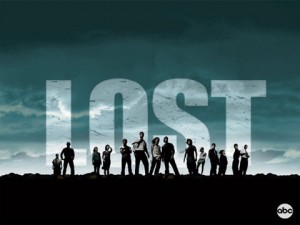 That dialogue spoke of a humanism, compassion, and respect for man’s potential (to be both good and evil), and can be compared to that of Frank Capra’s (the half-hour fantasy sequence in It’s a Wonderful Life, in which Jimmy Stewart’s George Bailey witnesses his life had he not been born, isn’t so much a throwback to Dickens’ A Christmas Carol as it is a proto-Twilight Zone episode). Both men tried to raise the consciousness of their audiences through commercial mediums, and were chided by critics (“Capracorn”), then and now, for lapsing into sentimental moralizing and soapbox reform.
That dialogue spoke of a humanism, compassion, and respect for man’s potential (to be both good and evil), and can be compared to that of Frank Capra’s (the half-hour fantasy sequence in It’s a Wonderful Life, in which Jimmy Stewart’s George Bailey witnesses his life had he not been born, isn’t so much a throwback to Dickens’ A Christmas Carol as it is a proto-Twilight Zone episode). Both men tried to raise the consciousness of their audiences through commercial mediums, and were chided by critics (“Capracorn”), then and now, for lapsing into sentimental moralizing and soapbox reform.
But if Serling was the Capra of TV, he was also the medium’s Orson Welles, for he exercised a Wellesian control over all creative facets of The Twilight Zone, making him the first dramatic television auteur; though crafted by many writers, directors and actors of different sensibilities, The Twilight Zone was ultimately united under one—Serling’s—vision. From the personal notes of producer Houghton, used as a guide for script purchases:
“The Twilight Zone is a world that allows for things to happen that do not happen in real life: fantasies operate, wishes are fulfilled, life’s loose ends are tied up, frustrations are resolved, discontents are played out, dreams come true, magic asked for is delivered. Unbridled imagination, working to the benefit—or destruction—of commonplace people…the writer is free to pose almost any ‘What if…?’ and proceed with it to some conclusion unfettered by the need to mirror real life; but he can never treat far-outness as an end in itself—the conclusion reached must ultimately appeal to our sense of truth, justice, or irony. It must have a crackling resonance in common human experience.”
Indeed, all the other Twilight Zone writers’ works fall under a set of recurring themes of Serling’s, “The Five Themes of The Twilight Zone,” a syllabus of the greatest episodes (selected from Seasons 1 & 2), and herein “submitted for your approval…”
A QUESTION OF IDENTITY
“The place is here…the time is now…and the journey into the shadows that we’re about to watch could be our journey…”
—Rod Serling’s opening narration to The Twilight Zone’s pilot episode, “Where is Everybody?,” October 2, 1959
 The first words spoken by Rod Serling at the beginning of The Twilight Zone’s first episode not only introduced the concept to an unsuspecting 1959 television audience, but ushered them into what would become “The Sixties,” a question of identity for America itself. Lethem, again: “What Serling created, above all else, was a homegrown vernacular of alienation, identity slippage and paranoia, and he did it right when it most needed doing, when his audience was starved for a vocabulary to express their uneasiness—and he did it on weekly television.”
The first words spoken by Rod Serling at the beginning of The Twilight Zone’s first episode not only introduced the concept to an unsuspecting 1959 television audience, but ushered them into what would become “The Sixties,” a question of identity for America itself. Lethem, again: “What Serling created, above all else, was a homegrown vernacular of alienation, identity slippage and paranoia, and he did it right when it most needed doing, when his audience was starved for a vocabulary to express their uneasiness—and he did it on weekly television.”
In “Where is Everybody?,” an amnesiac played by Earl Holliman wanders through a strangely deserted town and decries, “I’ve looked and I haven’t seen anybody around…maybe they’re all asleep or something, but literally, there hasn’t been a soul,” Serling himself observing the sleeping giant that was America in the Cold War conformity of the Eisenhower Fifties?
Holliman turns out to be an astronaut in training (torn from the day’s headlines, following the April ’59 naming of the Mercury Seven astronauts by NASA) who, following 484 hours in an isolation tank to prepare him for solo space travel to the moon (three years before JFK’s moon speech), cracked from loneliness and began to hallucinate what we, the audience, thought was the “reality” of the episode—the first Twilight Zone twist ending and still one of its metaphysically best, upending the tacit agreement between storyteller and audience that what you’re being shown is “real,” and endlessly imitated ever since (as in Leonardo Dicaprio’s two most recent films, Shutter Island and Inception).
A true pilot episode (and the greatest in the history of television) in that it included virtually all the existential and surreal motifs that would become associated with The Twilight Zone—isolation, fear, confusion with mannequins, hallucinogenic delusions that seem all too real—“Where is Everybody?” is finally a harrowing visualization of one man’s alienation from reality, indeed from one’s self, which would prove to be the defining, existential crisis facing man in the second half of the 20th Century, a time when the pit of man’s fears and the summit of his knowledge—the atomic bomb—first coexisted.
A few episodes after “Where is Everybody?” aired, Serling’s adaptation of a Richard Matheson story, “And When the Sky Was Opened,” also used the space race as a vehicle to explore the nature of identity—conflating the loss of it with the loss of one’s actual, corporeal self. Following a crash landing back on earth, we watch as, one by one, the three surviving astronauts literally disappear into thin air.
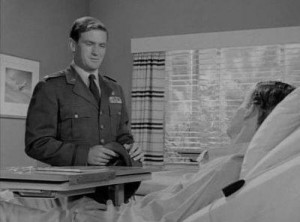 Originally, lead actor Rod Taylor’s disappearing scene “was written as a very painful experience, but I decided to make it a very euphoric experience,” recalled director Douglas Heyes in Marc Zicree’s Twilight Zone Companion. “Instead of playing it for terror or agony—everything had been fear up till then, fear of disappearing, fear of the unknown and so forth—I said to Rod Taylor, ‘Let’s play this as if this is the most marvelous thing that’s ever happened.’” Taylor’s ability to fulfill Heyes’ direction so convincingly is just one example of what became a standard on The Twilight Zone: performances so intense and driven that you can see the belief of the unbelievable on actors’ faces, from the sweat naturally beading on their brows to the absolutely crazed look in their eyes.
Originally, lead actor Rod Taylor’s disappearing scene “was written as a very painful experience, but I decided to make it a very euphoric experience,” recalled director Douglas Heyes in Marc Zicree’s Twilight Zone Companion. “Instead of playing it for terror or agony—everything had been fear up till then, fear of disappearing, fear of the unknown and so forth—I said to Rod Taylor, ‘Let’s play this as if this is the most marvelous thing that’s ever happened.’” Taylor’s ability to fulfill Heyes’ direction so convincingly is just one example of what became a standard on The Twilight Zone: performances so intense and driven that you can see the belief of the unbelievable on actors’ faces, from the sweat naturally beading on their brows to the absolutely crazed look in their eyes.
An actor who believes he is the man he plays discovers, in Matheson’s “A World of Difference,” “How thin a line separates that which we assume to be real with that manufactured inside of a mind?,” presaging the later-Sixties psychedelic reaction to life being like a movie, while raising age-old questions about destiny and pre-destiny, about man’s free will in a benevolent or malevolent universe. An ur-Twilight Zone episode, with actor Howard Duff giving one of those stark-ravingly believable performances.
The enigmatic Australian director Peter Weir, whose first breakthrough films, ‘75’s Picnic at Hanging Rock and ‘77’s The Last Wave, are like beautifully filmed, full-color, down under Twilight Zone episodes, directed 1998’s The Truman Show, about a man (Jim Carrey) who comes to find that his life, his reality, is a massive fabrication for television—a big screen blowup of Matheson’s television original.
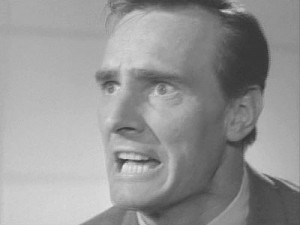 Though convicted murderer Dennis Weaver (in one of the epitomes of these tense Twilight Zone performances) tries to share his recurring nightmare of electrocution to his fellow death-row inmates in the aptly-titled “Shadow Play” (the second of Beaumont’s two definitive Twilight Zone episodes about the nature of dreams; the first, Season 1’s “Perchance to Dream,” is in the following theme “Suburban Nightmares”), beseeching anyone who’ll listen that they, too, are all part of his dream, it is to no avail—he is condemned to walk the last mile every night.
Though convicted murderer Dennis Weaver (in one of the epitomes of these tense Twilight Zone performances) tries to share his recurring nightmare of electrocution to his fellow death-row inmates in the aptly-titled “Shadow Play” (the second of Beaumont’s two definitive Twilight Zone episodes about the nature of dreams; the first, Season 1’s “Perchance to Dream,” is in the following theme “Suburban Nightmares”), beseeching anyone who’ll listen that they, too, are all part of his dream, it is to no avail—he is condemned to walk the last mile every night.
Writer/Director Cameron Crowe was so beholden to “Shadow Play” that he had it playing on the Jumbotron in a totally deserted Times Square (save for a panicked Tom Cruise) during the opening scene of his 2001 film Vanilla Sky (itself a remake of a ’97 Spanish film, Open Your Eyes), which deals with similar themes acted out in the twilight zone between dream and reality, as Beaumont concluded: “We exist, of course, but how? In what way? As we believe, as flesh and blood human beings?”
In “A World of His Own,” Matheson’s lighter-hearted sister episode to his own “A World of Difference,” a writer brings his characters to flesh and blood life, exclaiming to his disbelieving wife, “Fictional characters come alive! They come alive so vividly that they make decisions of their own! A playwright may have worked out some kind of move for them, but they refuse to do it! They become so strong that sometimes they take over the whole story!” The last episode of the landmark first season, “A World…” was based on Serling himself, who similarly dictated his scripts into a tape recorder, and featured his first on-screen Twilight Zone appearance—but at the end of the episode (Serling’s now iconically-familiar on-screen introductions began with The Twilight Zone’s second season in the fall of ‘60).
Dummies, doppelgangers, duplicates—The Twilight Zone was rife with them. Serling’s “Mirror Image” is concerned with “…different planes of existence, about two parallel worlds that exist side by side; and each of us has a counterpart in this world, and sometimes…this counterpart comes into our world…” Taking place in a nondescript bus station, peopled by drab figures immobile in the stark Americana like an Edward Hopper painting brought to life, “Mirror Image” is the most Hitchkockian of Twilight Zones— the suspense as palpable as the rain that beats down throughout the episode.
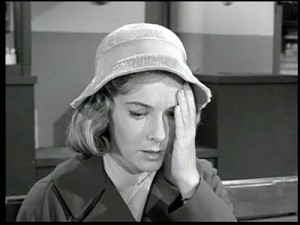 Vera Miles, who would go on to co-star in Hitchcock’s Psycho, gives the female equivalent of the intense Twilight Zone performance, dominated by male leads in this essay, her eyes glazing over as she unravels before our eyes to co-star Martin Milner (who would gain ‘60s TV fame as one-half of the Adam 12 duo in 1968.
Vera Miles, who would go on to co-star in Hitchcock’s Psycho, gives the female equivalent of the intense Twilight Zone performance, dominated by male leads in this essay, her eyes glazing over as she unravels before our eyes to co-star Martin Milner (who would gain ‘60s TV fame as one-half of the Adam 12 duo in 1968.
Inger Stevens’ dawning acceptance of her own true nature in Serling’s “The Lateness of the Hour,” the second of Stevens’ two superb Twilight Zone appearances (her first, “The Hitch-Hiker,” follows in “Suburban Nightmares”), was the first TZ episode of six to be videotaped in a cost-cutting measure during Season 2. Though uneven in quality, “The Lateness…,” due to Stevens’ compelling presence and performance, manages to rise above it.
“The Lonely,” by Serling, is Jack Warden, a convict serving his life sentence in solitary on a remote prison planet, who, in a gesture of compassion by the authorities, is given a female robotic companion, played by Jean Marsh (later of the British TV hit Upstairs, Downstairs). Though Warden loses himself in her lifelikeness, in the end, he is left alone, bitterly questioning his own—human—identity: “Reality’s what I need because what is there left that I can believe in? The desert and the wind? The silence? Or myself?”
In Part 3 of this series Schumer will continue to explore the themes of The Twilight Zone, picking up the discussion with consideration of “Suburban Nightmares.”
Arlen Schumer wrote and designed Visions From The Twilight Zone, the only coffee table art book about the series, and continues to present a multimedia show based on the book to universities and cultural institutions around the country, including The 2008 Rod Serling Conference at Ithaca University, and the 2009 New York Comic Convention, where he also presented his mini-marathon, “The Five Themes of The Twilight Zone.” He presented his new show, “The Twilight Zone Forever,” at The New York Times’ TimesCenter in New York on the exact 50th Anniversary of The Twilight Zone’s debut, October 2, 2009. On November 11 Schumer will make a presentation in connection with a screening the 50th anniversary of “The Eye of the Beholder” episode at the prestigious Tribeca Cinema. Tickets can be purchased here
The Twilight Zone season 1 & season 2 are available on Blu-ray DVD at the TheoFantastique Store.





2 Responses to “THE TWILIGHT ZONE FOREVER: On the release of Rod Serling’s The Twilight Zone Seasons 1 & 2 on Blu-ray (Part 2)”